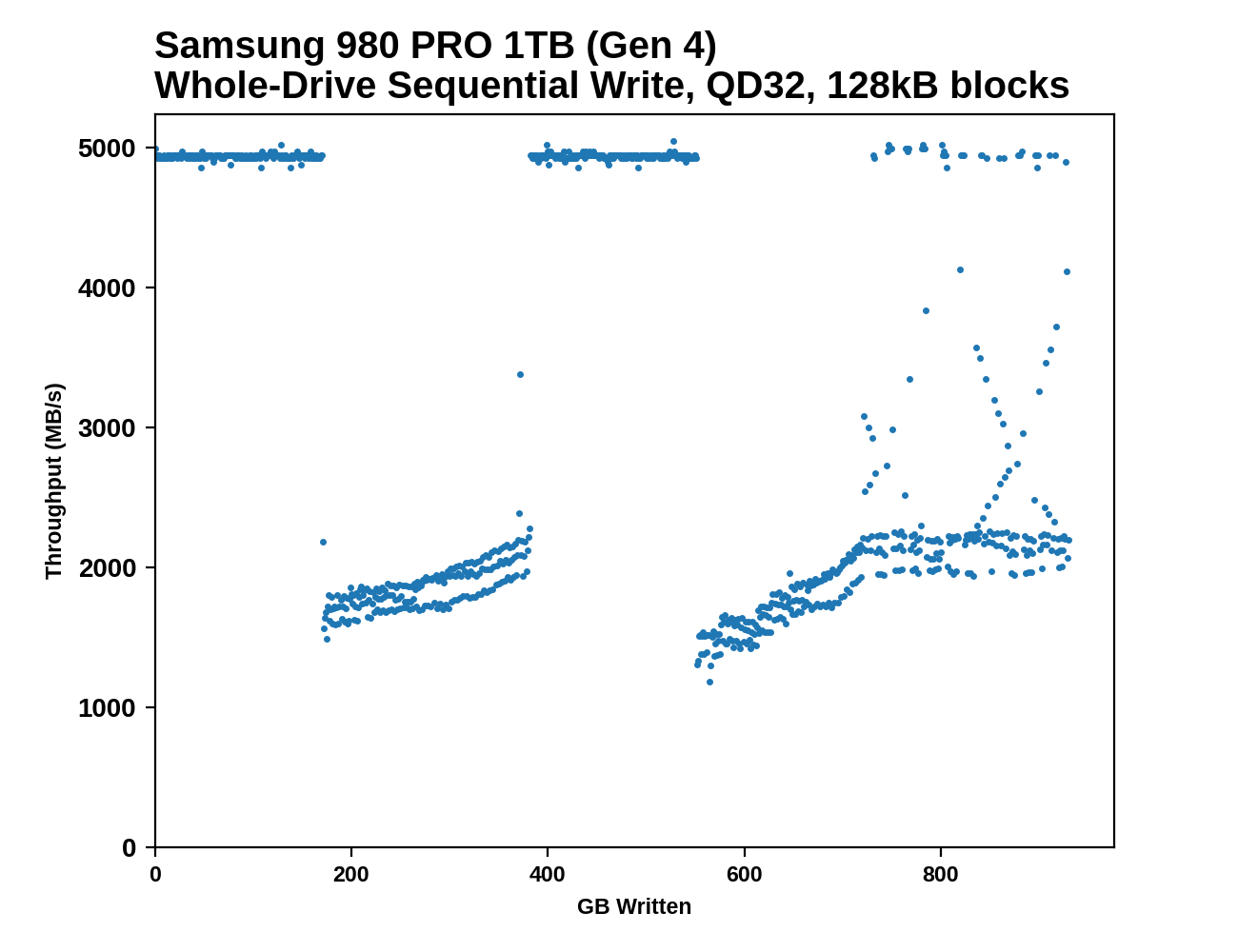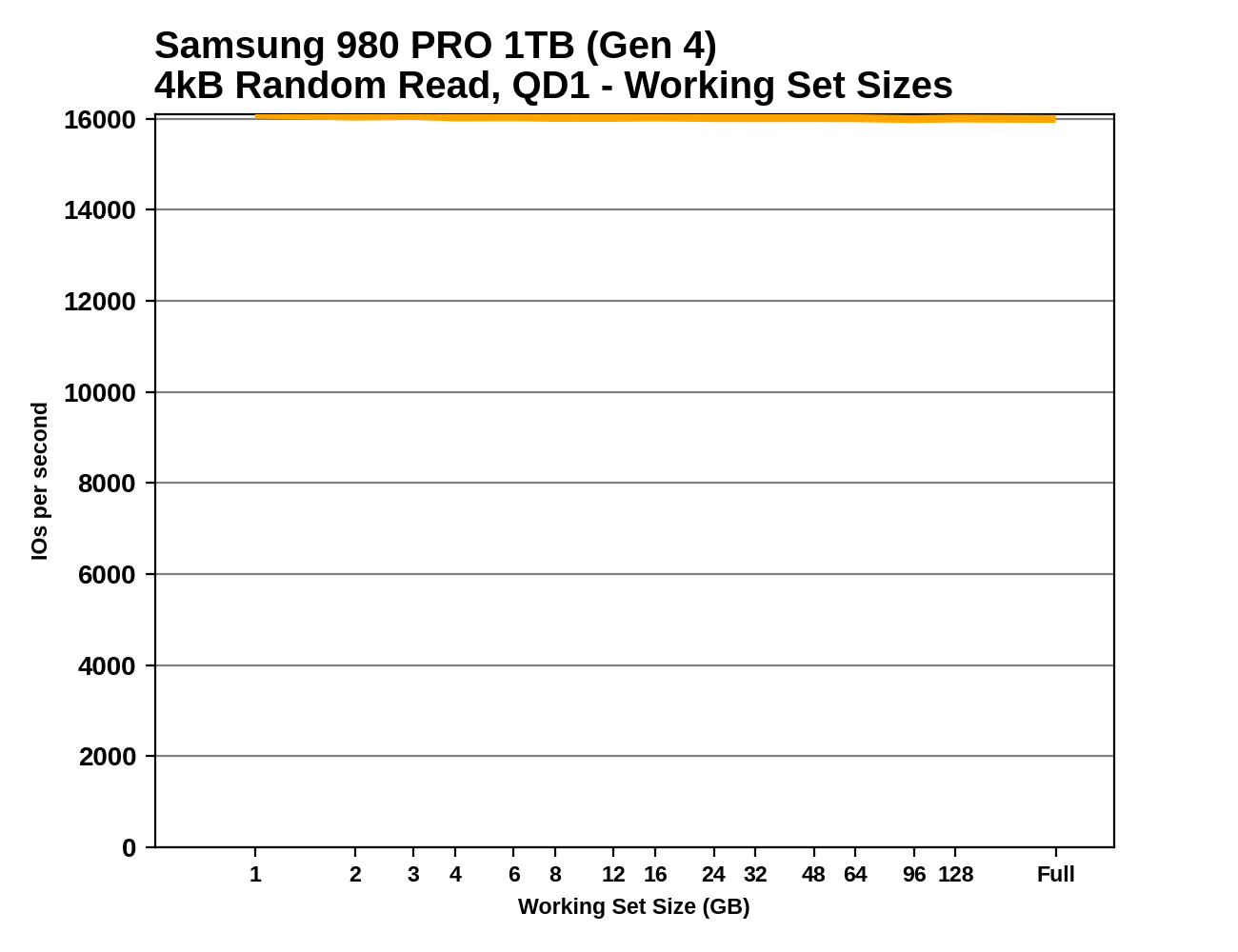The Samsung 980 PRO PCIe 4.0 SSD Review: A Spirit of Hope
by Billy Tallis on September 22, 2020 11:20 AM ESTWhole-Drive Fill
This test starts with a freshly-erased drive and fills it with 128kB sequential writes at queue depth 32, recording the write speed for each 1GB segment. This test is not representative of any ordinary client/consumer usage pattern, but it does allow us to observe transitions in the drive's behavior as it fills up. This can allow us to estimate the size of any SLC write cache, and get a sense for how much performance remains on the rare occasions where real-world usage keeps writing data after filling the cache.
 |
|||||||||
Both tested capacities of the 980 PRO perform more or less as advertised at the start of the test: 5GB/s writing to the SLC cache on the 1TB model and 2.6GB/s writing to the cache on the 250GB model - the 1 TB model only hits 3.3 GB/s when in PCIe 3.0 mode. Surprisingly, the apparent size of the SLC caches is larger than advertised, and larger when testing on PCIe 4 than on PCIe 3: the 1TB model's cache (rated for 114GB) lasts about 170GB @ Gen4 speeeds and about 128GB @ Gen3 speeds, and the 250GB model's cache (rated for 49GB) lasts for about 60GB on Gen4 and about 49GB on Gen3. If anything it seems that these SLC cache areas are quoted more for PCIe 3.0 than PCIe 4.0 - under PCIe 4.0 however, there might be a chance to free up some of the SLC as the drive writes to other SLC, hence the increase.
An extra twist for the 1TB model is that partway through the drive fill process, performance returns to SLC speeds and stays there just as long as it did initially: another 170GB written at 5GB/s (124GB written at 3.3GB/s on Gen3). Looking back at the 970 EVO Plus and 970 EVO we can see similar behavior, but it's impressive Samsung was able to continue this with the 980 PRO while providing much larger SLC caches—in total, over a third of the drive fill process ran at the 5GB/s SLC speed, and performance in the TLC writing phases was still good in spite of the background work to flush the SLC cache.
 |
|||||||||
| Average Throughput for last 16 GB | Overall Average Throughput | ||||||||
On the Gen4 testbed, the overall average throughput of filling the 1TB 980 PRO is only slightly slower than filling the MLC-based 970 PRO, and far faster than the other 1TB TLC drives. Even when limited by PCIe Gen3, the 980 Pro's throughput remains in the lead. The smaller 250GB model doesn't make good use of PCIe Gen4 bandwidth during this sequential write test, but it is a clear improvement over the same capacity of the 970 EVO Plus.
Working Set Size
Most mainstream SSDs have enough DRAM to store the entire mapping table that translates logical block addresses into physical flash memory addresses. DRAMless drives only have small buffers to cache a portion of this mapping information. Some NVMe SSDs support the Host Memory Buffer feature and can borrow a piece of the host system's DRAM for this cache rather needing lots of on-controller memory.
When accessing a logical block whose mapping is not cached, the drive needs to read the mapping from the full table stored on the flash memory before it can read the user data stored at that logical block. This adds extra latency to read operations and in the worst case may double random read latency.
We can see the effects of the size of any mapping buffer by performing random reads from different sized portions of the drive. When performing random reads from a small slice of the drive, we expect the mappings to all fit in the cache, and when performing random reads from the entire drive, we expect mostly cache misses.
When performing this test on mainstream drives with a full-sized DRAM cache, we expect performance to be generally constant regardless of the working set size, or for performance to drop only slightly as the working set size increases.
 |
|||||||||
Since these are all high-end drives, we don't see any of the read performance drop-off we expect from SSDs with limited or no DRAM buffers. The two drives using Silicon Motion controllers show a little bit of variation depending on the working set size, but ultimately are just as fast when performing random reads across the whole drive as they are reading from a narrow range. The read latency measured here for the 980 PRO is an improvement of about 15% over the 970 EVO Plus, but is not as fast as the MLC-based 970 PRO.










137 Comments
View All Comments
Tomatotech - Tuesday, September 22, 2020 - link
NAND has a long way to go yet. It took a while for SATA SSDs to take off then they were bumping at the top of the SATA bandwidth for many years. Now the PCIe NVME drives are shooting up in data transfer speeds faster than the PCIe committee can bring out new speeds. NVME drives were all clustered at the top of PCIe 3.0 for a few years; PCIe 4.0 has only just come out and already much of the new headroom has gone. At this point the main bottlenecks are the drive controller chips and the PCIe standards themselves. 5.0 is being rushed out for a reason and it isn’t for GPU cards.MFinn3333 - Wednesday, September 23, 2020 - link
Modern SSD's endurance being small is mostly a myth. The last test I saw was on a Crucial BX500 120GB and it wrote 1.2PB on it before it gave out while a smaller 32GB hit around 250TB. The amount of voltage hitting the cells has dropped significantly over the years when they switched to Charged Trap Flash.The 600TBW is the minimum the drive will write.
Pinn - Tuesday, September 22, 2020 - link
Curious about cooling. It looks bare but not near a GPU? Did you see thermal throttling?Billy Tallis - Tuesday, September 22, 2020 - link
The most recent SMART log for the 1TB 980 PRO indicates that it has spent about two minutes at or above the warning temperature (82C) but hasn't hit the critical temperature (85C). And that's out of about 14 power-on hours of testing. The SMART logs for the 250GB drive indicate that it has not hit its warning temperature.back2future - Tuesday, September 22, 2020 - link
What's the cells endurance and storage data stability compared at DWPD=0.3 on these high temperatures (179F, 82C) with long term comparison? What to expect on 5 year professional (high throughput) usage patterns?Oxford Guy - Tuesday, September 22, 2020 - link
“Samsung is abandoning the use of the two bit per cell (MLC) memory that has been the hallmark of the PRO product lines, and with the 980 PRO, Samsung is finally switching to three bit per cell (TLC) NAND flash memory.Along with switching to TLC NAND, Samsung has cut the write endurance ratings in half to 0.3 DWPD and dropped the usable capacities down to the typical TLC/EVO levels of 250/500/1000 GB instead of 256/512/1024 GB. TLC means the 980 PRO now relies on SLC caching for its peak write speeds, and write performance will drop substantially if the SLC cache is ever filled.”
Finally!
What consumers hope for: Worse endurance and worse performance. Higher profits for the company selling it.
Notmyusualid - Tuesday, October 6, 2020 - link
@ Oxford - pretty much sums it up for me.Whiteknight2020 - Tuesday, September 22, 2020 - link
"Pro" means precisely and exactly, absolutely 0% of sod all. And always has. Either a product fits ones particular use case or it does not. I'm a "pro", in that I design, integrate an build Telco grade data centre systems deployments. I don't have a use for 600TBW to a 1TB drive, I'll never write that in it's useful life. I don't have a use for 6GB/s transfer rates. I do have a use for multiterabyte ssds at reasonable (1GB/s) transfer rates. For me, that would be a "pro" drive. For other workloads an entirely different "pro" profile is needed. There are few blanket use cases, except perhaps standard consumer laptop drives.Oxford Guy - Tuesday, September 22, 2020 - link
"'Pro' means precisely and exactly, absolutely 0% of sod all."You're correct and you're incorrect.
You're correct in the sense that Samsung has rendered "Pro" no longer compelling by selling inferior TLC NAND in this product, undermining the established reputation of its Pro-labeled product line.
You're incorrect in terms of this:
"And always has."
This is objectively flatly false. Samsung's Pro-labeled products have existed in the market for quite some time. They have an established reputation for targeting a specific level of performance and having other characteristics, like high-endurance MLC NAND.
Tomatotech - Wednesday, September 23, 2020 - link
See the StoragePro review. This drive has some fantastic numbers under enterprise workloads.For home use? I’m not so sure about the value there. There’s a reason it’s called Pro.
https://www.storagereview.com/review/samsung-980-p...